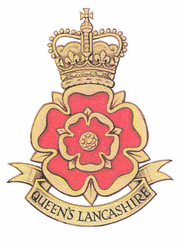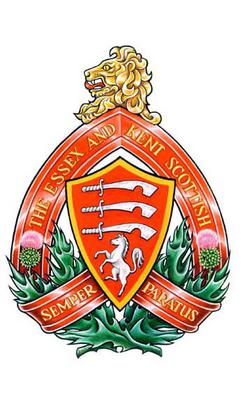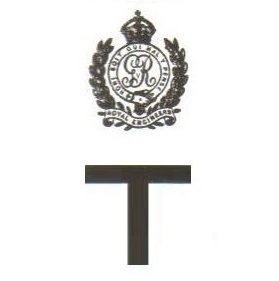
The Black Watch, 3rd Battalion, Royal Regiment of Scotland is an infantry battalion of the Royal Regiment of Scotland. The regiment was created as part of the Childers Reforms in 1881, when the 42nd Regiment of Foot was amalgamated with the 73rd (Perthshire) Regiment of Foot. It was known as The Black Watch from 1881 to 1931 and The Black Watch from 1931 to 2006. Part of the Scottish Division for administrative purposes from 1967, it was the senior Highland regiment. It has been part of the Scottish, Welsh and Irish Division for administrative purposes since 2017.

The 14th (Light) Division was an infantry division of the British Army, one of the Kitchener's Army divisions raised from volunteers by Lord Kitchener during the First World War. All of its infantry regiments were originally of the fast marching rifle or light infantry regiments, hence the title "Light". It fought on the Western Front for the duration of the First World War.
The division was disbanded by March 1919, and was not reformed in the Second World War.

The King's Own Scottish Borderers (KOSBs) was a line infantry regiment of the British Army, part of the Scottish Division. On 28 March 2006 the regiment was amalgamated with the Royal Scots, the Royal Highland Fusiliers, the Black Watch, the Highlanders, the Argyll and Sutherland Highlanders, 52nd Lowland Regiment, and 51st Highland Regiment to form the Royal Regiment of Scotland. However, after just a few months the battalion merged with the Royal Scots Battalion to form the Royal Scots Borderers.

The Queen's Lancashire Regiment (QLR) was an infantry regiment of the British Army, part of the King's Division. It was formed on 25 March 1970 at Connaught Barracks in Dover through the amalgamation of the two remaining Lancashire infantry regiments, the Lancashire Regiment and the Loyal Regiment. In July 2006 the regiment was amalgamated with two other Northern infantry regiments to form the Duke of Lancaster's Regiment.

The Welch Regiment was an infantry regiment of the line of the British Army in existence from 1881 until 1969. The regiment was created in 1881 under the Childers Reforms by the amalgamation of the 41st (Welch) Regiment of Foot and 69th Regiment of Foot to form the Welsh Regiment, by which it was known until 1920 when it was renamed the Welch Regiment. In 1969 the regiment was amalgamated with the South Wales Borderers to form the Royal Regiment of Wales.

The Essex and Kent Scottish is a Primary Reserve infantry regiment of the Canadian Army.

The Liverpool Scottish, known as "the Scottish", was a unit of the British Army, part of the Army Reserve, raised in 1900 as an infantry battalion of the King's. The Liverpool Scottish became affiliated to the Queen's Own Cameron Highlanders in the 1920s and formally transferred to the regiment in 1937 with its identity preserved. Reflecting the Territorial Army's decline in size since the late 1940s, the battalion was reduced to a company in 1967, then to a platoon of "A" (King's) Company, King's and Cheshire Regiment in 1999. In 2006, the company was incorporated into the 4th Battalion, Duke of Lancaster's Regiment.

The 7th Light Mechanised Brigade Combat Team is a formation in the British Army with a direct lineage to 7th Armoured Brigade and a history that stretches back to the Napoleonic Wars. It saw active service in the Crimean War, the Second Boer War and both the First and the Second World Wars. In 2014, the 7th Armoured Brigade was re-designated as 7th Infantry Brigade, thereby ensuring that the famed "Desert Rats" continue in the British Army's Order of battle.

The 15th Infantry Brigade, later 15 Brigade, was an infantry brigade of the British Army. It was part of the regular 5th Infantry Division during the First World War and Second World War, and was subsequently part of the 2nd Infantry Division in the north of the United Kingdom, with specific responsibility for the areas of North East England and Yorkshire and the Humber.

RE Grave, Railway Wood is a Commonwealth War Graves Commission (CWGC) memorial and war grave located in the Ypres Salient on the Western Front. It is located on the Bellewaerde Ridge near Zillebeke, about 4 kilometres east of Ypres, and a little north of Hooge. The area of the Cambridge Road sector, halfway in between Wieltje and Hooge, was the site of intensive underground fighting in the First World War. The Liverpool Scottish Memorial, Railway Wood is located nearby.

Hooge Crater Cemetery is a Commonwealth War Graves Commission burial ground for the dead of the First World War located in the Ypres Salient in Belgium on the Western Front. Hooge Crater Cemetery is named after a mine crater blown nearby in 1915 and located near the centre of Hooge, opposite the "Hooge Crater Museum" and separated from it by the Menin Road. Hooge itself is a small village on the Bellewaerde Ridge, about 4 kilometres east of Ypres in the Flemish province of West Flanders.

Hubert James Willey, DCM & Bar was twice awarded the Distinguished Conduct Medal, then the second highest British gallantry award, for his service on the Western Front, during the First World War.
Colonel Sir Jonathan Roberts Davidson was a British civil engineer and army officer. Davidson pursued a professional career as an engineer which resulted in him being elected president of both the Institution of Civil Engineers and of the Smeatonian Society of Civil Engineers. He also served as an officer in the Territorial Force where he saw combat as a battalion commander in the First World War with the Liverpool Scottish and was twice wounded in action.

Hooge is a small village on the Bellewaerde Ridge, about 4 kilometres east of Ypres in the Flemish province of West Flanders in Belgium. Hooge and the nearby locations of Bellewaerde and Zillebeke were merged into Ypres in 1976. The economy of Hooge is dominated by tourism and agriculture. Tourists are attracted by the World War I battlefields as well as Bellewaerde, the oldest operating theme park in Belgium.

The 177th Tunnelling Company was one of the tunnelling companies of the Royal Engineers created by the British Army during World War I. The tunnelling units were occupied in offensive and defensive mining involving the placing and maintaining of mines under enemy lines, as well as other underground work such as the construction of deep dugouts for troop accommodation, the digging of subways, saps, cable trenches and underground chambers for signals and medical services.

The 175th Tunnelling Company was one of the tunnelling companies of the Royal Engineers created by the British Army during World War I. The tunnelling units were occupied in offensive and defensive mining involving the placing and maintaining of mines under enemy lines, as well as other underground work such as the construction of deep dugouts for troop accommodation, the digging of subways, saps, cable trenches and underground chambers for signals and medical services.

In World War I, the area around Hooge on Bellewaerde Ridge, about 2.5 mi (4 km) east of Ypres in Flanders in Belgium, was one of the easternmost sectors of the Ypres Salient and was the site of much fighting between German and Allied forces.

The Lancashire Fusiliers War Memorial is a First World War memorial dedicated to members of the Lancashire Fusiliers killed in that conflict. Outside the Fusilier Museum in Bury, Greater Manchester, in North West England, it was unveiled in 1922—on the seventh anniversary of the landing at Cape Helles, part of the Gallipoli Campaign in which the regiment suffered particularly heavy casualties. The memorial was designed by Sir Edwin Lutyens. Lutyens was commissioned in light of a family connection—his father and great uncle were officers in the Lancashire Fusiliers, a fact noted on a plaque nearby. He designed a tall, slender obelisk in Portland stone. The regiment's cap badge is carved near the top on the front and rear, surrounded by a laurel wreath. Further down are inscriptions containing the regiment's motto and a dedication. Two painted stone flags hang from the sides.
The Bolton Rifles, later the 5th Battalion, Loyal North Lancashire Regiment, was a volunteer unit of the British Army from 1859 until 1967. It served on the Western Front during the First World War, and in the Far East during the Second World War, when one battalion was captured at the Fall of Singapore.

Herbert Francis Burden was a soldier in the British Expeditionary Force during the First World War. Born in 1898 in Lewisham, south-east London, Burden is generally accepted as having lied about his age in order to enlist at the age of 16. Having joined the 1st South Northumberland Fusiliers, he soon deserted, returned to London and joined the East Surrey Regiment, whom he also soon deserted. Rejoining his old battalion, he was sent to France when the army believed him to be 19 years old, and he probably fought at the Battle of Bellewaarde Ridge in May 1915. Having already gone absent without leave (AWOL) from his unit on multiple occasions, he left his post once again the following month—he said to see a friend in the neighbouring regiment—but he was arrested and accused of desertion. Found guilty, he was executed by firing squad two days later aged 17. In 2001 his case, and his image, was the basis for a memorial statue in the National Memorial Arboretum to those who had been unfairly executed by 20th-century standards. Five years later, Burden and the other men were granted pardons by the British government.


















